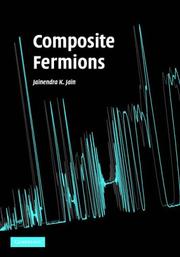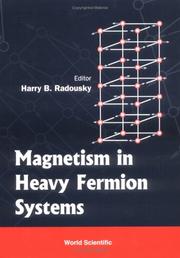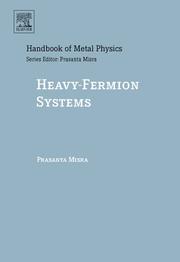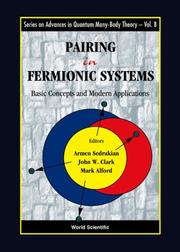| Listing 1 - 10 of 12 | << page >> |
Sort by
|
Book
ISBN: 9783030916725 Year: 2022 Publisher: Cham Springer International Publishing :Imprint: Springer
Abstract | Keywords | Export | Availability | Bookmark
 Loading...
Loading...Choose an application
- Reference Manager
- EndNote
- RefWorks (Direct export to RefWorks)
Fermions. --- Leptons (Nuclear physics) --- Particles (Nuclear physics) --- Fermions --- Fermi-Dirac particles --- Quantum statistics --- Interacting boson-fermion models

ISBN: 9780521862325 0521862329 9780511607561 9781107404250 0511607563 9780511286186 051128618X 9780511283840 0511283849 9780511282249 0511282249 9780511284649 0511284640 9780511285448 0511285442 1107404258 1107168597 1280909404 9786610909407 0511320965 Year: 2007 Publisher: Cambridge Cambridge University Press
Abstract | Keywords | Export | Availability | Bookmark
 Loading...
Loading...Choose an application
- Reference Manager
- EndNote
- RefWorks (Direct export to RefWorks)
This book was first published in 2007. When electrons are confined to two dimensions, cooled to near absolute zero temperature, and subjected to a strong magnetic field, they form an exotic new collective state of matter. Investigations into this began with the observations of integral and fractional quantum Hall effects, which are among the most important discoveries in condensed matter physics. The fractional quantum Hall effect and a stream of other unexpected findings are explained by a new class of particles: composite fermions. This textbook is a self-contained, pedagogical introduction to the physics and experimental manifestations of composite fermions. Ideal for graduate students and academic researchers, it contains numerous exercises to reinforce the concepts presented. The topics covered include the integral and fractional quantum Hall effects, the composite-fermion Fermi sea, various kinds of excitations, the role of spin, edge state transport, electron solid, bilayer physics, fractional braiding statistics and fractional local charge.
Fermions --- Fermions. --- Particles (Nuclear physics) --- Elementary particles (Physics) --- High energy physics --- Nuclear particles --- Nucleons --- Nuclear physics --- Fermi-Dirac particles --- Quantum statistics --- Interacting boson-fermion models --- Leptons (Nuclear physics)

ISBN: 1281934135 9786611934132 9812792651 9789812792655 9810243840 9810243480 9789810243487 9781281934130 Year: 2000 Publisher: Singapore : World Scientific,
Abstract | Keywords | Export | Availability | Bookmark
 Loading...
Loading...Choose an application
- Reference Manager
- EndNote
- RefWorks (Direct export to RefWorks)
Magnetism in Heavy Fermion Systems is a review volume which covers an important subset of topics in the field of heavy fermion and non-Fermi liquid physics. It summarizes much of the experimental information in these areas, and includes an article which discusses theoretical interpretations of the complex magnetic behavior of heavy fermion systems. The topics covered include heavy fermion superconductivity, muon spin relaxation in small-moment heavy fermions, neutron scattering from heavy fermions, random localized magnetism in heavy fermions, and magnetism in Pr-containing cuprates. One feature of the book which should be helpful to graduate students and new workers in the field is the extensive references and a separate list of review articles.
Fermions. --- Magnetism. --- Mathematical physics --- Physics --- Electricity --- Magnetics --- Fermi-Dirac particles --- Particles (Nuclear physics) --- Quantum statistics --- Interacting boson-fermion models --- Leptons (Nuclear physics)
Book
ISBN: 1280596155 9786613625984 0444538623 0444538577 9780444538574 9780444538628 9781280596155 6613625981 Year: 2012 Publisher: Amsterdam : Elsevier/Academic Press,
Abstract | Keywords | Export | Availability | Bookmark
 Loading...
Loading...Choose an application
- Reference Manager
- EndNote
- RefWorks (Direct export to RefWorks)
The rapidly developing topic of ultracold atoms has many actual and potential applications for condensed-matter science, and the contributions to this book emphasize these connections. Ultracold Bose and Fermi quantum gases are introduced at a level appropriate for first-year graduate students and non-specialists such as more mature general physicists. The reader will find answers to questions like: how are experiments conducted and how are the results interpreted? What are the advantages and limitations of ultracold atoms in studying many-body physics? How do experiments on ultracol
Photons. --- Fermions. --- Materials at low temperatures. --- Fluid mechanics --- Low temperature materials --- Low temperature engineering --- Materials --- Strength of materials --- Fermi-Dirac particles --- Particles (Nuclear physics) --- Quantum statistics --- Interacting boson-fermion models --- Leptons (Nuclear physics) --- Light quantum --- Light --- Einstein-Podolsky-Rosen experiment

ISBN: 1281076945 9786611076948 0080554679 0444515038 9780444515032 9780080554679 Year: 2008 Publisher: Amsterdam ; Boston : Elsevier,
Abstract | Keywords | Export | Availability | Bookmark
 Loading...
Loading...Choose an application
- Reference Manager
- EndNote
- RefWorks (Direct export to RefWorks)
The book on Heavy-Fermion Systems is a part of the Book series ""Handbook of Metal Physics"", each volume of which is written to facilitate the research of Ph.D. students, faculty and other researchers in a specific area. The Heavy-Fermions (sometimes known as Heavy-Electrons) is a loosely defined collection of intermetallic compounds containing rare-earth (mostly Ce) or actinide (mostly U) elements. These unusual names were given due to the large effective mass (100-1,000 times greater than the mass of a free electron) below a critical temperature. They have a variety of ground states includi
Fermions. --- Metals --- Chemistry, Physical and theoretical. --- Physical metallurgy. --- Microstructure. --- Metallurgy --- Physics --- Chemistry, Theoretical --- Physical chemistry --- Theoretical chemistry --- Chemistry --- Physical metallurgy --- Fermi-Dirac particles --- Particles (Nuclear physics) --- Quantum statistics --- Interacting boson-fermion models --- Leptons (Nuclear physics)
Book
ISBN: 6611786139 1281786136 9786611786137 1435677900 6000006306 1607503182 9781435677906 Year: 2007 Publisher: Amsterdam, Netherlands ; Washington, DC : Bologna, Italy : IOS Press ; Societa italiana di fisica,
Abstract | Keywords | Export | Availability | Bookmark
 Loading...
Loading...Choose an application
- Reference Manager
- EndNote
- RefWorks (Direct export to RefWorks)
The field of cold atomic gases faced a revolution in 1995 when Bose-Einstein condensation was achieved. The quest for ultra-cold Fermi gases started shortly after the 1995 discovery, and quantum degeneracy in a gas of fermionic atoms was obtained in 1999. This work covers experimental techniques for the creation and study of Fermi quantum gases.
Cold gases --- Electron gas --- Fermions --- Superfluidity --- Condensed degenerate gases --- Degenerate gases, Condensed --- Superfluids --- Liquid helium --- Low temperatures --- Quantum statistics --- Superconductivity --- Fermi-Dirac particles --- Particles (Nuclear physics) --- Interacting boson-fermion models --- Leptons (Nuclear physics) --- Fermi gas --- Electrons --- Gases
Book
ISBN: 1299333443 1614991979 9781614991977 Year: 2013 Publisher: Amsterdam ; Washington, DC : IOS Press,
Abstract | Keywords | Export | Availability | Bookmark
 Loading...
Loading...Choose an application
- Reference Manager
- EndNote
- RefWorks (Direct export to RefWorks)
The three-dimensional nucleon structure is central to many theoretical and experimental activities, and research in this field has seen many advances in the last two decades, addressing fundamental questions such as the orbital motion of quarks and gluons inside the nucleons, their spatial distribution, and the correlation between spin and intrinsic motion. A real three-dimensional imaging of the nucleon as a composite object, both in momentum and coordinate space, is slowly emerging.This book presents lectures and seminars from the Enrico Fermi School: Three-Dimensional Partonic Structure of the Nucleon, held in Varenna, Italy, in June and July 2011. The topics covered include: partonic distributions, fragmentation functions and factorization in QCD; theory of transverse momentum dependent partonic distributions (TMDs) and generalized partonic distributions (GPDs); experimental methods in studies of hard scattering processes; extraction of TMDs and GPDs from data; analysis tools for azimuthal asymmetries; models for TMDs and numerical methods; future experiments.The school aimed to educate postgraduate students to enable them to specialize in hard scattering and partonic azimuthal distributions analysis, thus equipping them to joining any of the current dedicated experiments or perform theoretical and phenomenological studies of TMDs and GPDs.
Nucleon-nucleon scattering --- Fermions --- Collisions (Nuclear physics) --- Fermi-Dirac particles --- Particles (Nuclear physics) --- Quantum statistics --- Interacting boson-fermion models --- Leptons (Nuclear physics) --- Nucleon scattering --- Nucleon-nucleon interactions --- Scattering (Physics)
Book
ISBN: 9811656762 9811656770 Year: 2021 Publisher: Singapore : Springer,
Abstract | Keywords | Export | Availability | Bookmark
 Loading...
Loading...Choose an application
- Reference Manager
- EndNote
- RefWorks (Direct export to RefWorks)
Topological insulators. --- Kondo effect. --- Fermions. --- Fermi-Dirac particles --- Particles (Nuclear physics) --- Quantum statistics --- Interacting boson-fermion models --- Leptons (Nuclear physics) --- Electric resistance --- Magnetic materials --- Solids --- Insulators, Topological --- Electric insulators and insulation --- Electronic apparatus and appliances --- Electric properties --- Materials

ISBN: 1281924555 9786611924553 9812773045 9789812773043 9789812569073 9812569073 9781281924551 Year: 2006 Volume: v. 8 Publisher: Singapore ; Hackensack, NJ : World Scientific,
Abstract | Keywords | Export | Availability | Bookmark
 Loading...
Loading...Choose an application
- Reference Manager
- EndNote
- RefWorks (Direct export to RefWorks)
Cooper pairing of fermions is a profound phenomenon that has become very important in many different areas of physics in the recent past. This book brings together, for the first time, experts from various fields involving Cooper pairing, at the level of BCS theory and beyond, including the study of novel states of matter such as ultracold atomic gases, nuclear systems at the extreme, and quark matter with application to neutron stars. Cross-disciplinary in nature, the book will be of interest to physicists in many different specialties, including condensed matter, nuclear, high-energy, and a
Fermions. --- Many-body problem. --- Pairing correlations (Nuclear physics) --- Superconductivity. --- Correlations, Pairing (Nuclear physics) --- Hartree-Fock approximation --- Wave functions --- n-body problem --- Problem of many bodies --- Problem of n-bodies --- Mechanics, Analytic --- Electric conductivity --- Critical currents --- Superfluidity --- Fermi-Dirac particles --- Particles (Nuclear physics) --- Quantum statistics --- Interacting boson-fermion models --- Leptons (Nuclear physics)
Book
ISBN: 3642018491 9786613559777 3642018505 1280381868 Year: 2010 Publisher: Heidelberg : Springer,
Abstract | Keywords | Export | Availability | Bookmark
 Loading...
Loading...Choose an application
- Reference Manager
- EndNote
- RefWorks (Direct export to RefWorks)
The lattice formulation is at present the most successful approach to Quantum Chromodynamics - the theory of quarks and gluons. This book is intended for newcomers to the field and presents a clear and easy-to-follow path from the first principles all the way to actual calculations. It focusses on QCD and discusses mainly SU(3) lattice gauge theory, both with and without fermions. Numerical calculations in lattice field theory have now become the most effective approach for obtaining quantitative results, and thus three chapters include sections describing numerical techniques, as used in pure gauge theory, in quenched spectroscopy and in treating dynamical fermions.
Quantum chromodynamics --- Lattice dynamics --- Physics --- Nuclear Physics --- Atomic Physics --- Physical Sciences & Mathematics --- Quantum chromodynamics. --- Lattice theory. --- Fermions. --- Fermi-Dirac particles --- Lattices (Mathematics) --- Space lattice (Mathematics) --- Structural analysis (Mathematics) --- Chromodynamics, Quantum --- QCD (Nuclear physics) --- Physics. --- Elementary particles (Physics). --- Quantum field theory. --- Elementary Particles, Quantum Field Theory. --- Numerical and Computational Physics. --- Particles (Nuclear physics) --- Quantum statistics --- Interacting boson-fermion models --- Leptons (Nuclear physics) --- Algebra, Abstract --- Algebra, Boolean --- Group theory --- Set theory --- Topology --- Transformations (Mathematics) --- Crystallography, Mathematical --- Quantum electrodynamics
| Listing 1 - 10 of 12 | << page >> |
Sort by
|

 Search
Search Feedback
Feedback About UniCat
About UniCat  Help
Help News
News